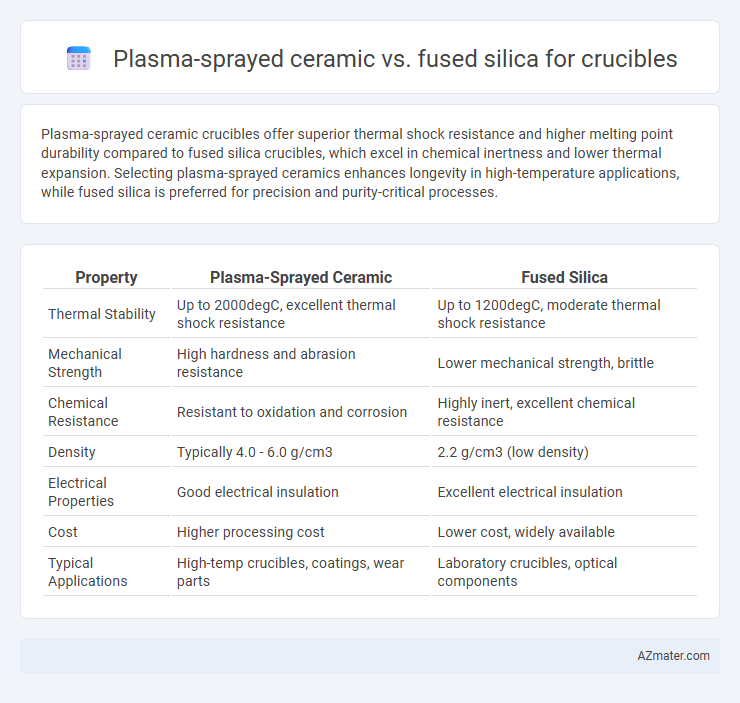Plasma-sprayed ceramic crucibles offer superior thermal shock resistance and higher melting point durability compared to fused silica crucibles, which excel in chemical inertness and lower thermal expansion. Selecting plasma-sprayed ceramics enhances longevity in high-temperature applications, while fused silica is preferred for precision and purity-critical processes.
Table of Comparison
| Property | Plasma-Sprayed Ceramic | Fused Silica |
|---|---|---|
| Thermal Stability | Up to 2000degC, excellent thermal shock resistance | Up to 1200degC, moderate thermal shock resistance |
| Mechanical Strength | High hardness and abrasion resistance | Lower mechanical strength, brittle |
| Chemical Resistance | Resistant to oxidation and corrosion | Highly inert, excellent chemical resistance |
| Density | Typically 4.0 - 6.0 g/cm3 | 2.2 g/cm3 (low density) |
| Electrical Properties | Good electrical insulation | Excellent electrical insulation |
| Cost | Higher processing cost | Lower cost, widely available |
| Typical Applications | High-temp crucibles, coatings, wear parts | Laboratory crucibles, optical components |
Introduction to Crucible Materials
Crucible materials such as plasma-sprayed ceramics and fused silica play a critical role in high-temperature applications due to their exceptional thermal resistance and chemical stability. Plasma-sprayed ceramic coatings offer enhanced durability and thermal shock resistance by providing a dense, adherent layer that withstands extreme environments. Fused silica, known for its low thermal expansion and high purity, is favored for applications requiring precise temperature control and minimal contamination.
Overview of Plasma-Sprayed Ceramic Crucibles
Plasma-sprayed ceramic crucibles feature a dense, wear-resistant coating applied through high-temperature plasma spraying, enhancing thermal stability and corrosion resistance compared to fused silica crucibles. These crucibles exhibit superior mechanical strength and can withstand rapid temperature fluctuations, making them ideal for demanding metallurgical and high-temperature chemical processes. Their microstructural integrity reduces contamination risks, ensuring purity and durability in industrial applications.
Properties and Composition of Fused Silica Crucibles
Fused silica crucibles exhibit exceptional thermal stability, low thermal expansion, and high chemical purity, primarily composed of nearly pure silicon dioxide (SiO2) in an amorphous glassy state. Plasma-sprayed ceramic crucibles typically consist of alumina or zirconia-based coatings, which offer enhanced mechanical strength and wear resistance but may have higher thermal expansion and potential porosity. The intrinsic low coefficient of thermal expansion and outstanding resistance to thermal shock make fused silica crucibles ideal for high-temperature applications requiring minimal contamination and dimensional stability.
Thermal Stability Comparison
Plasma-sprayed ceramic crucibles exhibit superior thermal stability withstanding temperatures up to 1800degC, while fused silica crucibles typically endure only around 1200degC before softening or deforming. The enhanced thermal resistance of plasma-sprayed ceramics results from their dense, tightly bonded microstructure, which reduces thermal shock and erosion. Fused silica's lower thermal conductivity and higher thermal expansion can lead to cracking under rapid temperature fluctuations, limiting its application in high-temperature processes.
Chemical Resistance Analysis
Plasma-sprayed ceramic crucibles exhibit superior chemical resistance due to their dense microstructure and stable oxide compositions, effectively resisting corrosion from aggressive molten metals and slags. Fused silica crucibles offer excellent thermal shock resistance but are more susceptible to chemical degradation in highly alkaline or acidic environments. Comparative studies highlight plasma-sprayed ceramics' enhanced durability and longer service life under harsh chemical conditions, making them preferable for industrial applications involving reactive melts.
Cost and Availability Factors
Plasma-sprayed ceramic crucibles offer high thermal resistance and wear durability but come with higher production costs and limited availability compared to fused silica. Fused silica crucibles are more cost-effective and widely accessible due to abundant raw materials and established manufacturing processes. The choice between the two depends heavily on budget constraints and the specific thermal performance requirements in industrial applications.
Mechanical Strength and Durability
Plasma-sprayed ceramic crucibles exhibit superior mechanical strength due to their dense microstructure and hardened surface, making them highly resistant to thermal shock and mechanical wear compared to fused silica. Fused silica crucibles offer lower mechanical strength but excel in thermal insulation and chemical inertness, limiting their durability under high-stress mechanical conditions. The choice between plasma-sprayed ceramics and fused silica depends on application-specific requirements, with plasma-sprayed ceramics favored for demanding environments requiring enhanced toughness and extended service life.
Performance in High-Temperature Applications
Plasma-sprayed ceramic crucibles exhibit superior thermal shock resistance and enhanced erosion resistance compared to fused silica, making them ideal for extreme high-temperature applications exceeding 1400degC. The porous structure of plasma-sprayed ceramics allows for better thermal insulation and durability under cyclic heating conditions, whereas fused silica, with a lower melting point around 1710degC, tends to suffer from deformation and devitrification at sustained elevated temperatures. Consequently, plasma-sprayed ceramic crucibles deliver higher performance stability and longer service life in industrial processes such as metal casting and semiconductor manufacturing.
Maintenance and Longevity Considerations
Plasma-sprayed ceramic crucibles offer enhanced durability and resistance to thermal shock, reducing maintenance frequency compared to fused silica, which is more prone to cracking and degradation under extreme temperature cycles. The superior wear resistance of plasma-sprayed ceramics extends crucible lifespan, minimizing downtime and replacement costs in high-temperature applications. Fused silica crucibles, while offering excellent thermal insulation, require more careful handling and regular inspections to prevent contamination and mechanical failure over time.
Choosing the Right Crucible Material: Plasma-Sprayed Ceramic vs Fused Silica
Plasma-sprayed ceramic crucibles offer superior thermal shock resistance and higher melting point durability compared to fused silica, making them ideal for high-temperature industrial applications. Fused silica crucibles excel in chemical inertness and low thermal expansion, which ensures dimensional stability during precision experiments requiring minimal contamination. Selecting between plasma-sprayed ceramic and fused silica depends on balancing thermal performance needs with chemical compatibility and specific operating temperature ranges.

Infographic: Plasma-sprayed ceramic vs Fused silica for Crucible
 azmater.com
azmater.com